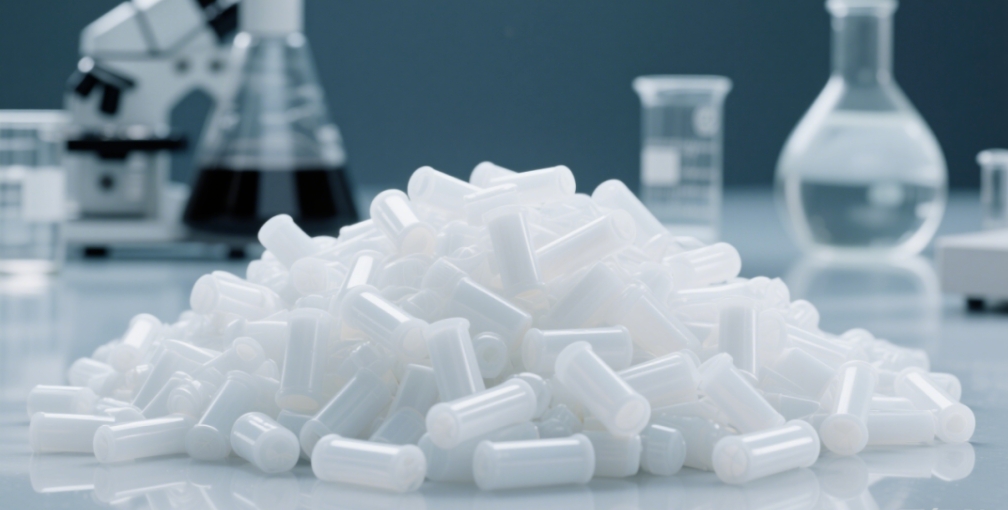Blogs & RFQ
Semiconductor Learning Series — Fluororesins PTFE/FEP/PFA/PVDF/ETFE/PCTFE/THV/PVF
Fluororesins in the Semiconductor Industry
Fluororesins (such as polytetrafluoroethylene, PTFE, and polyvinylidene fluoride, PVDF) are widely used in semiconductor manufacturing due to their exceptional corrosion resistance, high purity, insulation properties, and heat resistance. They are essential materials for key components like wafer processing equipment, etching chambers, pipelines, and seals, playing a critical role in ensuring chip yield and equipment stability.In 2023, the global market size for semiconductor-grade fluororesins was approximately $800 million, and it is projected to reach $1.8 billion by 2030, with a compound annual growth rate (CAGR) of about 10%. The main drivers of this growth are the expansion of the global semiconductor industry, the surge in demand for advanced processes (below 3nm), third-generation semiconductors (SiC/GaN), and AI chips.

What Are Fluororesins?
Fluororesins are synthetic polymer compounds containing fluorine atoms on the main or side carbon chains. They can be processed into plastic products, reinforced plastics, and coatings. Based on processing characteristics, fluororesins are divided into two main categories:
Non-melt-processable fluororesins (represented by PTFE)
Melt-processable fluororesins (including FEP, ETFE, PVDF, etc.)
I. Non-Melt-Processable Fluororesins
1. Polytetrafluoroethylene (PTFE)
PTFE, commonly known as "Teflon," is a fully fluorinated polymer where all hydrogen atoms are replaced by fluorine, giving it unique physical and chemical properties.Key Properties:
Main Applications: Chemical anti-corrosion linings, sealing materials, non-stick coatings, high-frequency circuit substrates○ Ultra-low surface energy: excellent non-stick and self-lubricating properties
○ Outstanding chemical inertness: resistant to strong acids, bases, and almost all organic solvents
○ Excellent thermal stability: continuous use up to 260°C
○ Superior dielectric properties: low dielectric constant (2.1), suitable for high-frequency electronics
○ Radiation resistance: withstands high-energy radiation without significant degradation
II. Melt-Processable Fluororesins
These can be shaped using conventional thermoplastic methods such as injection molding and extrusion. Main types include:1. Fluorinated Ethylene Propylene (FEP)
A copolymer of tetrafluoroethylene (TFE) and hexafluoropropylene (HFP), FEP has reduced crystallinity compared to PTFE, allowing melt processing while retaining most of PTFE’s excellent properties.Key Properties:
○ Wide temperature range: 190°C to 205°CMain Applications: Wire and cable insulation, high-frequency transmission lines, chemical pipeline linings
○ Excellent electrical insulation (dielectric constant 2.1)
○ Low smoke, low flame spread, meets flame retardancy requirements
○ Good chemical stability
2. Perfluoroalkoxy (PFA)
A copolymer of TFE and a small amount of perfluoroalkoxy vinyl ether (PPVE), PFA’s ether bonds provide greater flexibility and thermal stability.Key Properties:
○ Continuous use temperature up to 260°C (similar to PTFE)Main Applications: Semiconductor equipment parts, high-purity chemical storage tanks, medical-grade tubing
○ Higher mechanical strength than PTFE, stress crack resistance
○ Excellent chemical inertness and electrical properties
3. Polyvinylidene Fluoride (PVDF)
A homopolymer of vinylidene fluoride (VDF), PVDF has partial crystallinity (45%–70%), combining the chemical resistance of fluororesins with the mechanical properties of engineering plastics.Key Properties:
○ Temperature range: 60°C to 150°CMain Applications: Lithium battery separators, photovoltaic back sheets, chemical anti-corrosion coatings, piezoelectric films
○ Excellent weather resistance, UV aging resistance
○ Piezoelectric and pyroelectric properties, suitable for sensor materials
○ Good dielectric properties
4. Ethylene Tetrafluoroethylene (ETFE)
An alternating copolymer of ethylene (E) and TFE, ETFE combines the chemical resistance of fluororesins with the mechanical properties of polyethylene.Key Properties:
○ High mechanical strength, impact and wear resistanceMain Applications: Architectural membrane structures (e.g., "Water Cube"), aerospace cable sheaths, solar cell encapsulation materials
○ Light transmittance up to 95%, suitable for architectural membranes
○ Continuous use temperature 150°C, short-term up to 240°C
5. Polychlorotrifluoroethylene (PCTFE)
A homopolymer of chlorotrifluoroethylene (CTFE), PCTFE has very high crystallinity (85%–90%) and excellent barrier properties.Key Properties:
○ Superior water vapor barrier, suitable for high-seal environmentsMain Applications: Pharmaceutical packaging, spacecraft seals, optical window materials
○ Outstanding low-temperature performance, usable down to -200°C
○ High transparency, can be made into optical-grade materials
6. Amorphous Fluororesins (Transparent Fluororesins)
Produced by copolymerizing TFE with specific fluorinated monomers, these have a completely amorphous structure, combining high transparency with chemical resistance.Key Properties:
○ Light transmittance close to glass, suitable for optical devicesMain Applications: Optical communication components, microelectronic packaging, anti-fouling optical coatings
○ Low refractive index, usable for optical fiber coatings
○ High heat resistance (Tg up to 240°C)
7. THV Terpolymer
A terpolymer of TFE, HFP, and VDF, THV offers excellent flexibility and processability.Key Properties:
○ Low processing temperature (230–250°C), easy to moldMain Applications: Medical catheters, flexible electronic packaging, composite film materials
○High transparency, can be made into flexible films
○ Can bond with other materials, suitable for composite applications
8. Polyvinyl Fluoride (PVF)
A homopolymer of vinyl fluoride (VF), PVF is known for its outstanding weather and corrosion resistance.Key Properties:
○ Exceptional weather resistance, outdoor service life up to 30 yearsMain Applications: Photovoltaic backsheet protective films, architectural anti-corrosion coatings, high-end packaging materials
○ Chemical corrosion resistance, suitable for harsh environments
○ Good mechanical strength

